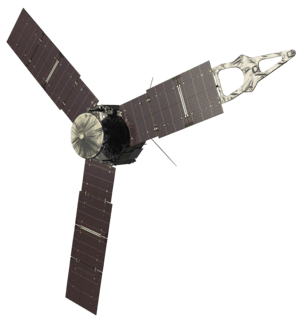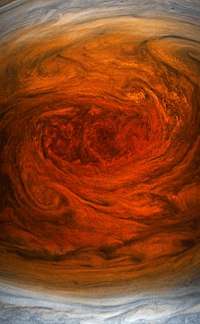Waves (Juno)
Waves is an experiment on the Juno spacecraft to study radio and plasma waves.[1][2] It is part of collection of various types of instruments and experiments on the spacecraft; Waves is oriented towards understanding fields and particles in Jupiter's magnetosphere.[2] Waves is on board the unmanned Juno spacecraft, which was launched in 2011 and arrived at Jupiter in the summer of 2016.[1] The major focus of study for Waves is Jupiter's magnetosphere, which if could be seen from Earth would be about twice the size of a full moon.[3] It has a tear drop shape, and that tail extends away from the Sun by at least 5 AU (Earth-Sun distances).[3] The Waves instrument is designed to help understand the interaction between Jupiter's atmosphere, its magnetic field, its magnetosphere, and to understand Jupiter's auroras.[4] It is designed to detect radio frequencies from 50 Hz up to 40,000,000 Hz (40 MHz),[5] and magnetic fields from 50 Hz to 20,000 Hz (20 kHz).[6] It has two main sensors a dipole antenna and a magnetic search coil.[6] The dipole antenna has two whip antenna's that extend 2.8 meters (110 inches/ 9.1 feet) and they are attached to the main body of the spacecraft.[6][7] This sensor has been compared to a rabbit ears set-top TV antenna.[8] The search coil is overall a mu metal rod 15 cm (6 in) length with a fine copper wire wound 10,000 times around it.[6] There are also two frequency receivers that each cover certain bands.[6] Data handling is done by two radiation hardened systems on a chip.[6] The data handling units are located inside the Juno Radiation Vault.[9] Waves was allocated 410 Mbits of data per science orbit.[9]
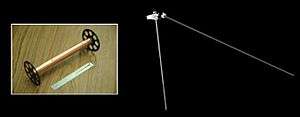
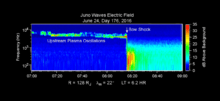
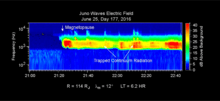
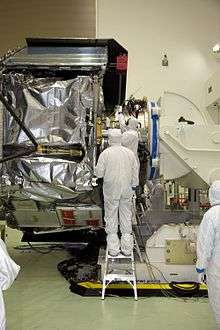
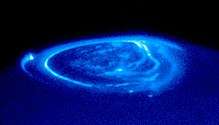
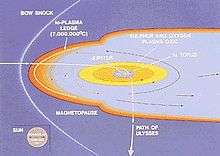
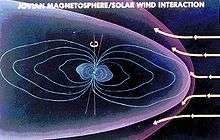

On June 24, 2016 the Waves instrument recorded Juno passing across Jupiter's magnetic field's bow shock.[3] It took about two hours for the unmanned spacecraft to cross this region of space.[3] On June 25, 2016 it encountered the magnetopause.[3] Juno would go on to enter Jupiter's orbit in July 2016.[3] The magnetosphere blocks the charged particles of the solar wind, with the number of solar wind particles Juno encountered dropping 100-fold when it entered the Jovian magnetosphere.[3] Before Juno entered it, it was encountering about 16 solar wind particles per cubic inch of space.[3]
There is various other antenna on Juno including the communication antennas and the antenna for the Microwave Radiometer.[9]
Two other instruments help understand the magnetosphere of Jupiter, Jovian Auroral Distributions Experiment (JIRAM) and Magnetometer (MAG) instrument.[10] The JEDI instrument measures higher energy ions and electrons and JADE lower energy ones, they are complementary.[10] Another object of study is plasma generated by volcanism on Io (moon) and Waves should help understand that phenomenon also.[6]
A primary objective of the Juno mission is to explore the polar magnetosphere of Jupiter. While Ulysses briefly attained latitudes of ~48 degrees, this was at relatively large distances from Jupiter (~8.6 RJ). Hence, the polar magnetosphere of Jupiter is largely uncharted territory and, in particular, the auroral acceleration region has never been visited. ...
— A Wave Investigation for the Juno Mission to Jupiter[11]
Another issue that came up in 2002, was when Chandra determined with its high angular resolution that X-rays were coming from Jupiter's poles.[12] Einstein Observatory and Germany's ROSAT previously observed X-rays from Jupiter.[12] The new results by Chandra, which took the observations during December 2000, showed X-rays coming from the magnetic north pole not the aurora.[12] Roughly every 45 minutes Jupiter sends out a multi-gigawatt X-ray pulse, and this is synchronized with an emission in radio at 1 to 200 kHz.[12] Galileo orbiter and Ulysses solar orbiter picked up the radio emissions every 45 minutes.[12] The radio emissions were discovered before the X-rays, they have been detected since the 1950s, and there is even Citizen astronomer project orchestrated by NASA called Radio Jove for anyone to listen to Jupiter's radio signals.[13][14] Kilometric radio radiation was not detected until the Voyager flybys of Jupiter in the late 1970s.[14] Two candidates for the source of the X-rays are particles of Solar wind or from Io.[12]
Waves was developed at the University of Iowa, and the experiment is led by a research scientist there.[8]
Sensors
There are two main sensors for Waves, and these field signals to the frequency receivers.[6] Both sensors are attached to main spacecraft body.[6]
- Dipole antenna
- Magnetic search coil
The MSC is made of a rod of Mu-metal (a ferromagnetic alloy of nickel and iron) wrapped in fine copper wire.[6]
Frequency receiver
There are two frequency receivers that each cover certain bands, a high band and a low band, which in turn has different receiving sections.[6] The receivers are housed in the Juno Radiation Vault along with other electronics.[9]
Breakdown:[6]
- High Frequency Receiver[6]
- High Frequency Receiver ~100 kHz - 40 MHz (Spectrum (High) and Waveform (Low))[6]
- High Frequency Waveform Receiver[6]
- Baseband receiver includes:[6]
- variable-gain amplifier[6]
- 100 Hz to 3 MHz band-pass filter[6]
- 12-bit analog-to-digital converter[6]
- Double sideband heterodyne receiver for 3 to 40 MHz (swept frequency receiver)[6]
- Baseband receiver includes:[6]
- Low Frequency Receiver[6]
All outputs are sent to the Data Processing Unit (DPU)[6]
Data Processing Unit (DPU)
The output from the frequency receivers is in turn processed by the Juno DPU.[6] The DPU has two microprocessors that use field programmable gate arrays are they are both system on chip designs.[6] The two chips:[6]
- Y180 intellectual property core
- Floating point arithmetic unit
The DPU sends data to the main Juno computer for communication with Earth.[6] The electronics are in the Juno Radiation Vault along with the receivers.[9]
Multimedia
Waves has detected radio emissions from the Jupiter auroras, the most powerful known in the Solar System to date.[15]
See also
- Other instruments on Juno
- Radio
- Plasma
- Waves in plasmas
- Ulysses (spacecraft)
- Magnetosphere of Jupiter
- Radio astronomy
- FIELDS (investigation on the Parker Solar Probe, launched summer of 2018)
- Plasma Wave Subsystem (Instrument on the Voyager probes)
References
- Greicius, Tony (2015-03-13). "Juno Spacecraft and Instruments". NASA. Retrieved 2017-01-04.
- 4, Geoff Brown / Published Jan; 2017 (2016-06-30). "NASA's Juno and JEDI prepare to unlock the mysteries of Jupiter". The Hub. Retrieved 2017-01-04.CS1 maint: numeric names: authors list (link)
- Greicius, Tony (2016-06-29). "NASA's Juno Spacecraft Enters Jupiter's Magnetic Field". NASA. Retrieved 2017-01-05.
- "Juno's Instruments | Mission Juno". Mission Juno. Retrieved 2017-01-05.
- Sampl, M.; Oswald, T.; Rucker, H. O.; Karlsson, R.; Plettemeier, D.; Kurth, W. S. (November 2011). "First results of the JUNO/Waves antenna investigations". 2011 Loughborough Antennas Propagation Conference: 1–4. doi:10.1109/LAPC.2011.6114038. ISBN 978-1-4577-1016-2.
- "Jupiter rendezvous". 2016-06-29.
- "Juno, and its University of Iowa-built instrument, about to reach Jupiter | The Gazette". The Gazette. Retrieved 2017-02-08.
- "Press Release".
- Kurth, et al - A Wave Investigation for the Juno Mission to Jupiter - 2008
- "Puzzling X-rays from Jupiter | Science Mission Directorate". science.nasa.gov. Retrieved 2017-02-08.
- Sky and Telescope - The Radio Jove Project: Listening in on Jupiter - 2013
- John W. McAnally (2007). Jupiter: and How to Observe It. Springer Science & Business Media. p. 82. ISBN 978-1-84628-727-5.
- "Juno Sends Back Incredible New Images of Jupiter | Planetary Science, Space Exploration | Sci-News.com". Breaking Science News | Sci-News.com. Retrieved 2018-01-24.
